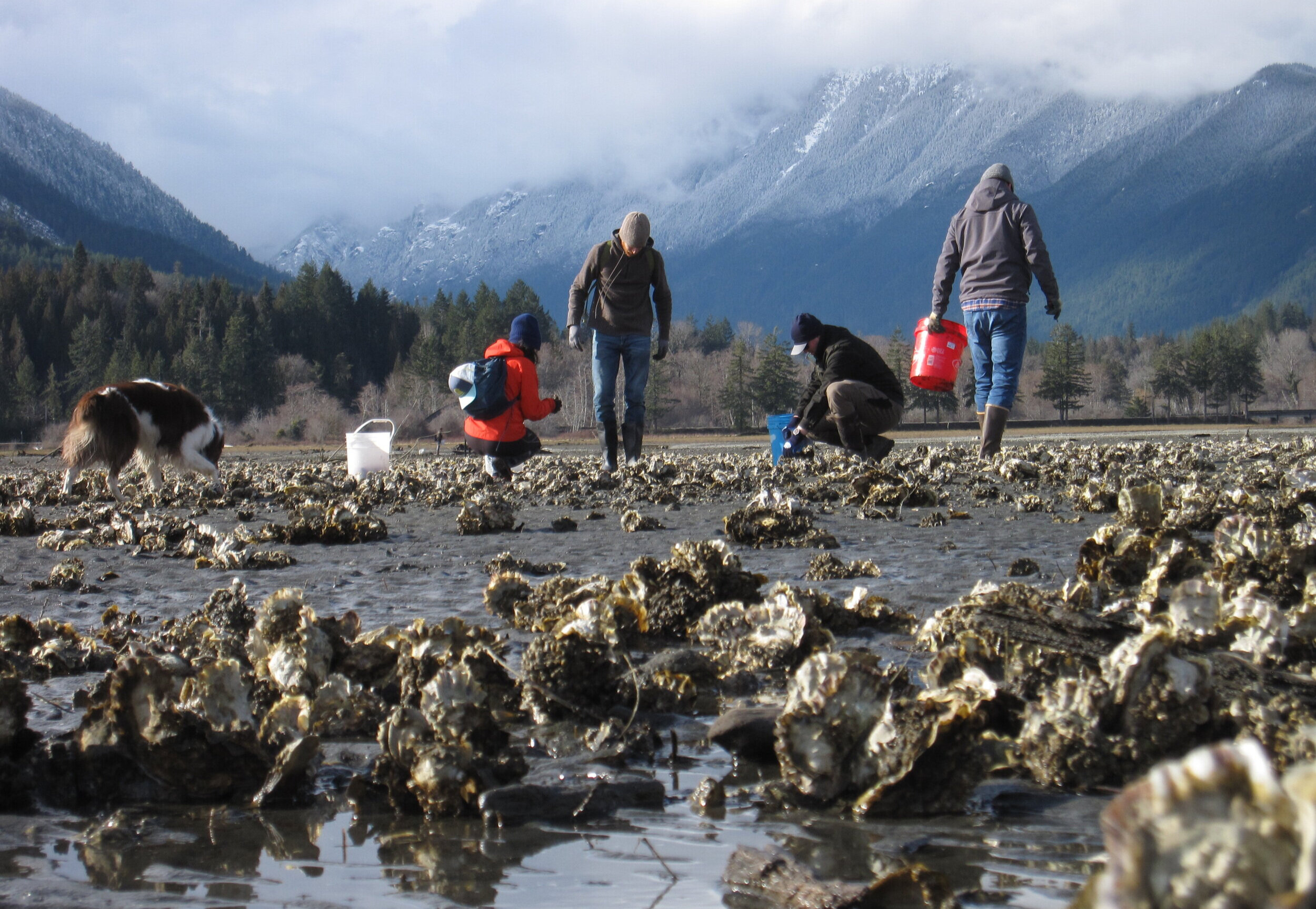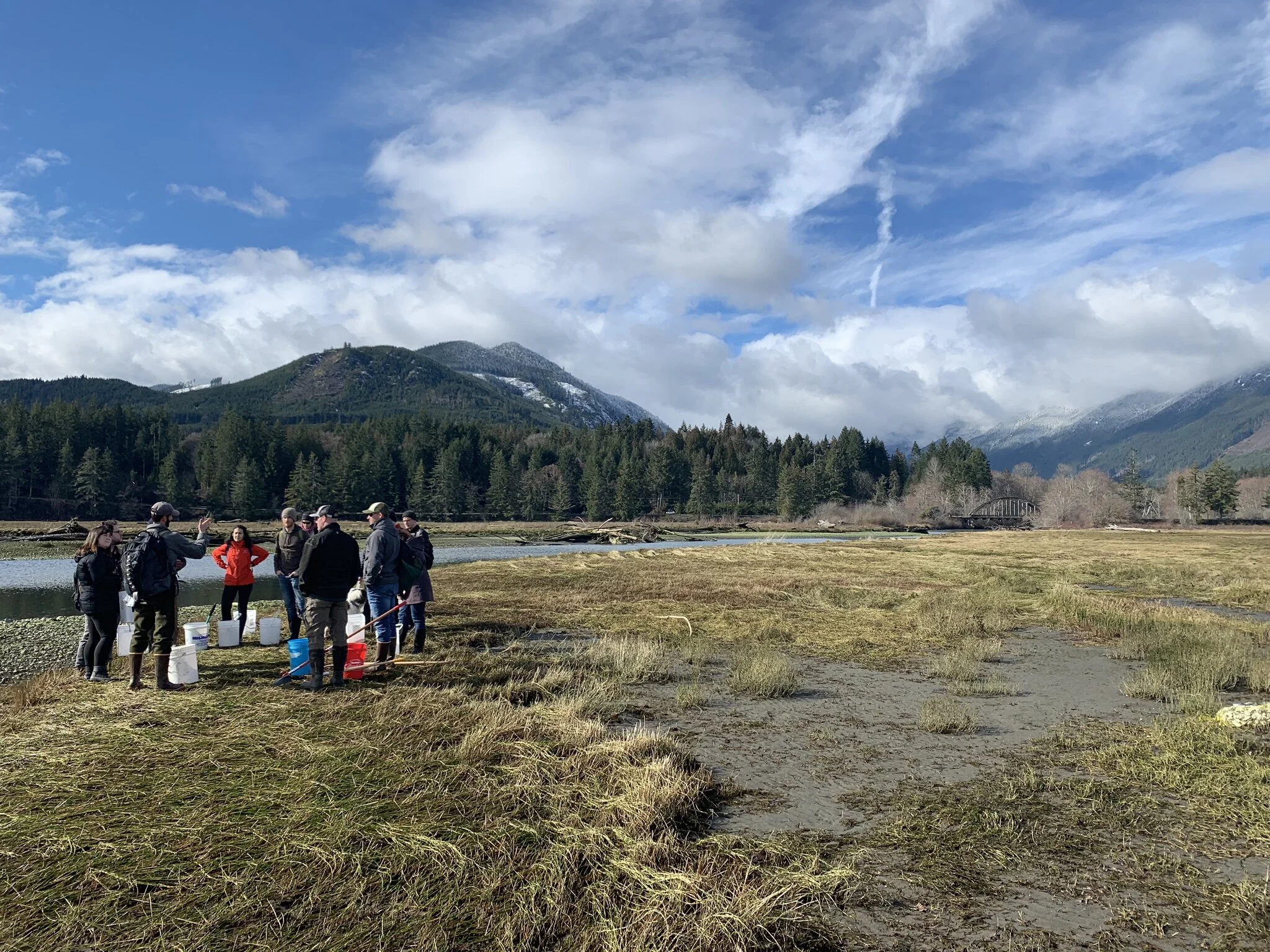
Learn how to shuck oysters, dig clams, and prepare your catch
Shellfish Forage and a Feast
Learn to Dig Clams & Shuck Oysters + Gourmet Meal on the Beach
Hood Canal, Washington
Join us on the tide flats of Hood Canal for an intimate and quintessential Northwest experience foraging and eating wild shellfish in this one-day holistic educational and culinary experience. Learn where, when and how to identify and dig manila clams and gather oysters, how to prepare your catch (shuck oysters), and enjoy a gourmet meal from your own freshly foraged shellfish prepared by a professional chef. Take home fresh clams and oysters for your family and friends. Leave with the knowledge and confidence to forage and prepare shellfish on your next outing, and a greater awareness of our connection to the land.
2025 Course Dates
Forage & 3-course Meal by Professional Chef
Friday, March 21, 2025 | 1:30 - 7:30 PM (Waitlist)
Saturday, March 22, 2025 | 2:30 - 8:30 PM (Reserved for Private Event)
Saturday, March 29, 2025 | 9 AM - 3 PM (Waitlist)
Sunday, March 30, 2025 | 9:30 AM - 3:30 PM (waitlist)
Included With Course
Group shellfishing license for the day (you do not need to purchase a license for this course but you will need one to forage in the future)
Personal instruction on how and where to find and identify manila clams and oysters, and other clams
Oyster shucking lessons
Overview of the State regulations
Health and safety considerations
Gourmet meal on-site prepared by a chef: steamed clams, raw & pan-fried oysters, seasonal/foraged greens, etc.
Wine (and a hot drink on the tide flats to take the chill off)
Personal digital photo album of the day.
What To Bring
Clothing & Equipment
Rubber boots or water shoes (for wading through shin-high water)
Rubber-palmed (or leather) gardening gloves or cloth rag for shucking sharp oysters. Or cut resistant shucking gloves.
The following six items are included in the gear rental:
Cultivator rake or long handled, or similar
Oyster knife 3 - 4 in. for larger oysters
Clam net (used produce net works great)
Bucket (doubles as a stool)
Clam gauge for measuring (1.5”)
Quart jar or container for oyster meat
Layers appropriate for weather (and wind chill)
Water bottle
Camp cup (insulated coffee cup, etc.) for a hot drink on the beach and cold wine with the meal.
Bowl + Fork + Handkerchief (we’d rather not create rubbish with disposable stuff; and it is a little more sanitary this way)
Small backpack (optional for short walk to the tide flats)
Camp chair (for sitting around the fire after foraging)
Headlamp (for late afternoon tides)
Food for kids under 7 years old
If you Plan to take home shellfish - also bring:
Cooler with ice
Airtight container for shucked oyster meat (a pint jar with lid works well - 16 oz.)
A bucket for sea water to let your clams soak (this is not critical but will keep the clams alive for a few days and allow them to flush)
Location
Hood Canal, near Brinnon, and Quilcene, WA (Final location will be chosen and shared the week prior, based on water quality updates from the WDFW and DOE and shellfish sampling.)
Consider staying the night at the Dosewallips State Park Campground or a local Air BnB (see links below).
Clamming and Conservation
We live in a unique place to be able to collect and enjoy such a bounty of seafood, right in our back yard. Clams and oysters (bivalves) are considered by some a superfood with their high levels of vitamins and minerals. These nutrient-rich mollusks are also a vital part of our ecosystem with their efficient filter feeding. This course will introduce you to an area abundant with life that spends a good portion of the time underwater, called the intertidal zone.
One way to protect our natural resources is to experience them firsthand and show gratitude for our amazing biodiversity. Realizing the joy of eating wild shellfish foraged by our own hands moments earlier is a wonderful reminder that everything is connected and we are stewards of this great land.
Bruce McGlenn
About your instructor/Guide
Bruce is a third-generation shellfish forager in the state of Washington. His folks, who incorporated him into their fishing and foraging trips from the beginning, are the ones to thank for his love and connection to the Salish Sea. During family salmon fishing trips to Pillar Point in the Strait of Juan de Fuca, Bruce's grandmother, Harriet (while not busy teaching him and his brother and sister to play cribbage) would accompany him on the beach at low tide when he was too young yet to fish all day with the adults. Countless hours of looking under rocks and observing the complex life in tide pools etched into his psyche two ideas. One, nature is awesome; and two, everything is connected. Give him a chance to show you the wonders of the intertidal zone and you won't be disappointed. You may be surprised how good it feels to tap into your inner hunter/gatherer...
Marcus Peterson
About your chef
Marcus grew up in the Pacific Northwest and often spent summers with farm and family in North Carolina. Foraging, fishing, farm life and hunting have all been integral from the beginning - starting early with family foraging trips to earn his allowance. His cooking skill comes from both his mother and collaborating with other chefs, his knife skills come from a traditionally trained sushi chef, but Marcus’ love for the meal comes from connecting the rich cultural flavors living abroad in Japan, Taiwan, Indonesia, and Europe. Marcus has owned and operated two successful restaurants, but his favorite kitchen has always been in the backcountry. Cooking after a successful day and utilizing the limited available resources guides his creativity in turning a meal into an even finer cuisine with sometimes unexpected combinations that strengthen the connections between those sitting around the fire.
Testimonials
satiating for both the body and soul
My husband and I, along with our three “tween” boys, joined Bruce and Taus (the dynamic duo!) for the Shellfish Forage and Feast class. The crowd that gathered drew from all walks of life. There were families, couples, friends…you name it.
Bruce led us down to the tidal flats and patiently instructed, demonstrated and provided support while we all treasure hunted for our clams! My boys loved this part the best! Next, the group was treated to freshly foraged oysters on the half shell with not one…not two…but FOUR handmade condiments. The presentation was lovely and the oysters and toppings simply divine!
We then foraged our oysters and Bruce again instructed us all with Zen-like calm through the shucking process. Everyone left with ten fingers and full bellies! The group then headed back to the shore where the world-famous Danish Chef was busily concocting our Shellfish Feast! Steamed Clams, Fried Breaded Oysters, Handmade Bread and Asparagus. All from the back of his truck!
These guys know their stuff, are passionate and generous in sharing their knowledge and provide an amazing afternoon that is not only enjoyable and informative but also satiating for both the body and soul. Thank you for doing what you do!
- Sarah Campbell, Seattle, WA
Vegetarian's Perspective
I have been vegetarian for 6 years now and contemplating eating meat again. I'm studying Ayurveda which talks about eating from the 5 elements for optimal balance. I felt so much energy and have been happy with my eating choices after going vegetarian, but as always, I'm curious about new ways of thinking and approaching diet and life. It's important for me to eat from local, sustainable food sources whenever possible with a huge bonus if I can forage it myself. Also, the research being done on the feeling and consciousness of plants has me reconsidering the way I look at nourishment as a whole. I came across Bruce's information stand at the Ballard Farmer's Market and he was such a gentle, non-judgmental guy, I thought it would be a safe place to explore eating meat again. Boy, was I right!
The location of the shellfish site was beautifully picturesque. I was surprised to meet other vegetarians, former vegetarians and vegans, hunters, and oyster enthusiasts on the learning quest with me. The environment felt safe and open to discussion with gentle curiosity, and no need for hard-fast-solid explanations or beliefs on a perfect "best" way to eat. The culture of community that was present was surprising in the best kind of way.
The actual forage was very informative. Bruce was present and readily available for questions and gave lots of tips on how to find good spots and what to look for when digging for clams or looking for oysters. We reviewed state laws on harvesting requirements and water safety testing before heading out together. It felt like a treasure hunt digging for food and each time I was so excited to find a clam instead of a rock!
The reflection after the event had me mindful of portion sizes and the impact that "food greed" takes on the environment. When I have leftover produce in the fridge from the grocery store I feel bad, but it's another level when I'm taking things from nature and have seen the land and understand the circle of effect of my actions. I am so thankful to have ventured on this trip. Never having lived near the ocean as a child, I wondered if I would have enough of the basic information needed to start learning. After attending, I feel I can confidently look for oysters and clams as I was given all information in an easy and understandable way. I highly recommend Bruce's classes to all my friends and everyone curious about hunting, sustainability, environmental impact, and holistic approaches to food. I can't wait to go on the next Human Nature Hunting course!
ALSO, the way the food was prepared was AMAZING! It is nice to eat the foraged food as it's best version and to know what it can taste like when well prepared. This made it easier to prepare at home as I had a base starting point for a food I was otherwise unfamiliar with. Everyone eating outside together and chatting afterwards about the experience was a true highlight and perfect ending.
- Hannah Boyd, Seattle, WA
you create community around a shared goal, which turns into a shared feast
What you have going is so special-- you create community around a shared goal, which turns into a shared feast. You supply knowledge and teach people how to do things with their own two hands. It’s accessible to a family who is looking to spend time together in nature, as well as to a solo attendee looking to build a skill.
What you have to offer is so much more interesting than the fancy "sit down and be served while you drink bottles of wine" outings. Part of what I loved about my experience with HNH is that I came home smelling like oysters!! It was up to me to forage for my food. It was up to me to do my part so that everyone could enjoy a nice meal. It was up to me to ensure I was able to take some of what I found back home. I'd rather don my XTRATUFs and wade the shoreline, take my bounty to a shady spot to have it cooked up in various ways, and all the while acquiring knowledge, hot tips, and new acquaintances. Thank you for the unforgettable day!
- Erin Gainey, Orcas Island, WA
reconnecting with a piece of my heritage
“I had a fantastic time foraging with Bruce. I learned all the essentials of clamming and oystering so that I can now do it on my own with my family. Bruce is patient, knowledgeable, and passionate about sharing his love for the outdoors with his clients. I felt like I was reconnecting with a piece of my heritage by harvesting and eating nature’s bounty right there on the beautiful tide flat. Thank you, Bruce!”
- Amy Waeschle, Poulsbo, WA
“Looking for oysters is like going on a treasure hunt.”
- Elsa, age 9
“I liked digging for clams. And measuring them!”
- Lauren, age 6
pleasure of owning your meal from start to finish
I went shellfishing last Sunday with the Human Nature Hunting School. It was a super fun day of sand, sun, and delicious eats. We hunted for clams and oysters and fried them up right on the beach. I just made a big batch of clam chowder last night with my catch. So delicious!! I would recommend this experience to anybody looking to experience the pleasure of owning your meal from start to finish.
- April Neubauer, Seattle, WA
freedom to roam and explore
Participating alongside other eager oyster novices was delightful at the Forage and a Feast last weekend. My limit of manila clams were steamed in pinot grigio, fresh limes and a fist of fresh parsley...when we finished those tasty morsels with a green salad, hubby asked me to pan fry the 18 oysters for dessert.! The freedom to roam and explore is encouraged in Bruce's class, and I highly recommend wearing the Teva sandals to feel the cool river water while packing your quarry of 40 clams back to the cookstove.
- Kristie Westergaard Miller, Tacoma, WA
I guarantee that if you take this class it will be a one-of-a-kind experience!
For anyone who’s ever wondered how to go about local oyster and clam foraging this is a really excellent class and adventure! Bruce and his team worked with our small group to make sure the entire afternoon was not only relaxing but educational as well. The "classroom" was beautiful out on the Olympic Peninsula, and it was great to get back to nature and really study the techniques on how to forage for this type of food. And the best part was the gourmet dinner Bruce's team made for us right off the beach using our recent catch. I am recommending this to my friends. I guarantee that if you take this class it will be a one-of-a-kind experience!
- Mike Enright, Seattle, WA
Caring for and Cooking Your Catch
Transport
Steamer Clams
Stop along the drive home (Hood Canal Bridge - Shine Tidelands, or along the Canal if headed south) and get a third of a bucket of fresh, clean, cool seawater (must be saltwater, not river water) in which to soak your clams. Ensure the bucket (or cooler) is void of residues from chemicals or cleaners. As long as the water stays cool they will last a few days like this and expel extra sand, etc. If you don't have seawater, they can be stored for several days in a bowl in the refrigerator with a damp towel over them. They should close up when tapped. If the shell remains open after squeezing them they likely have expired.
Oysters
After shucking on the beach and leaving the shells (required by law) place in an airtight container on ice in a cooler. They should keep in the refrigerator for several days and can be frozen for a few months without noticeable compromise to quality.
Field Recipes
Steamer Calms
Human Nature Steamed Manila or Native Littleneck Clams (in the Field)
1 - 2 limits (40-80 clams)
approx. 1/2 cup white wine (or water)
1/2 stick of butter (more or less to taste)
hearty sprinkling of dill
Cover and steam in a pot on high until it appears that most or all of the clams have popped wide open (usually within 5 min.) then continue steaming for an additional minute or two for good measure. Add a crusty bread for dipping into the clam nectar (juices in the pot). Word from the wise: if a clam doesn’t open in the pot, don’t eat that one.
Alternatively, there are countless recipes to try online.
Oysters
Human Nature Pan-Fried Oysters (in the Field)
Cover in flour (wholewheat or white) by dredging or shaking in a bag
Fry in high-heat oil (grapeseed, ghee, refined coconut) AND BUTTER until browned and slightly crispy. Butter will help them brown.
Salt and pepper to taste.
Highly recommended to use a cast iron frying pan. Serve with lemon juice and tartar sauce for added flavors.
Explore other fried oyster recipes and oyster stew recipes.
Shellfish rules | weather | Tide tables| Local Information | Community
WA Dept. of Fish & Wildlife Shellfishing Overview: Rules & Regulations
NOAA Zone Weather Forecast | Weather Underground 10-day Forecast
Mikes Beach Resort Make it an overnight and save 10% in March with code: HUMANNATURE25
Get involved with the Puget Sound Restoration Fund Shellfish Farm


































